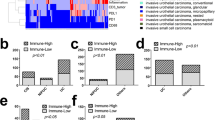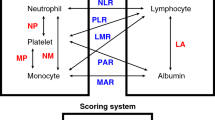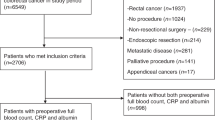Abstract
The relationship between tumour stage, grade, elevated C-reactive protein concentration (<10/>10 mg l−1), adjuvant therapy and survival was examined in patients with biopsy proven bladder cancer (n=105). On multivariate analysis stage (HR 3.37, 95% CI 1.37–8.29, P=0.008), grade (HR 2.01, 95% CI 1.14–3.57, P=0.017) and preoperative C-reactive protein (HR 3.31, 95% CI 1.09–10.09, P=0.035) were independently associated with cancer-specific survival.
Similar content being viewed by others
Main
Bladder cancer is the fourth most common malignancy in United Kingdom in men and the eighth in women with a total of 12 500 new cases each year causing 5000 deaths annually (CRC CancerStats, 2002). More than 90% of bladder cancers diagnosed in the Western world, are transitional cell carcinomas and constitute a significant proportion of the general urological consultants' workload due to its high prevalence and recurrent nature.
It is increasingly recognised that, in addition to tumour stage, disease progression is dependent on a complex interaction of the tumour and host inflammatory response (Balkwill and Mantovani, 2001; Coussens and Werb, 2002). Indeed, the systemic inflammatory response, as evidenced by elevated circulating concentrations of C-reactive protein, has been shown to be a stage independent prognostic factor in a variety of operable tumours (Mahmoud and Rivera, 2002; Ikeda et al, 2003; McMillan et al, 2003). To our knowledge there has been only one previous study that has examined the prognostic value of C-reactive protein in patients with invasive bladder cancer (O'Quigley et al, 1981).
The aim of the present study was to examine the relationship between stage, grade, C-reactive protein and cancer-specific survival in patients with superficial or invasive bladder cancer.
Patients and methods
Patients with biopsy proven transitional cell carcinoma presenting to a single urological unit at Glasgow Royal Infirmary between 1992 and 1999 were reviewed. Those patients with a measurement of C-reactive protein prior to or 3–6 months following transurethral resection of bladder tumour were included in the study as previously described (McMillan et al, 2003). Tumour stage was assessed using the UICC guidelines, and tumour grade performed according to the WHO grading system. Date and cause of death were obtained from the Cancer Registry, Scotland using ICD 9 code (bladder cancer 1889).
Routine laboratory measurement of patient's serum for C-reactive protein concentration was performed. The limit of detection of the assay was a C-reactive protein concentration lower than 5 mg l−1. The coefficient of variation, over the range of measurement, was less than 5% as established by routine quality control procedures. C-reactive protein measurement of greater than 10 mg l−1 was considered to indicate the presence of systemic inflammatory response. (O'Gorman et al, 2000).
The Research Ethics Committee of North Glasgow NHS Trust approved the study.
Statistical analysis
Survival analysis was performed using the Cox proportional hazard model with patient age, sex, tumour stage and grade and C-reactive protein concentration as prognostic variables. Deaths up to September 2004 were included in the analysis.
Multivariate survival analysis was performed using stepwise backward procedure to derive a final model of the variables that had a significant independent relationship with survival. To remove a variable from the model, the corresponding P-value had to be a greater than 0.10. Analysis was performed using SPSS software (SPSS, Chicago, IL, USA).
Results
The characteristics of patients with bladder cancer (n=105) are shown in Table 1. The majority were male, over the age of 65 years, had superficial disease (Ta, T1) and had elevated C-reactive protein concentrations either pre- or postoperatively. In total, 24 patients had adjuvant therapy (eight radiotherapy, eight BCG, eight cystectomy).
In all, 32 patients had C-reactive protein concentrations determined both prior to and following the resection. Of the 20 patients with an elevated preoperative value, 12 (60%) had a raised concentration after the operation. Of the 12 patients with a normal preoperative value, nine (75%) had a postoperative value in the normal range.
During the follow-up period 80 patients died, 41 of them from bladder cancer and the mean cancer-specific survival was 82.9 months (95% confidence interval 70.8–94.9). On univariate analysis, stage (P<0.001), grade (P<0.01) and elevated C-reactive protein preoperatively (P<0.05) and postoperatively (P<0.01) were significantly associated with overall survival. Also, stage (P<0.001), grade (P<0.001) and elevated C-reactive protein preoperatively (P<0.05) and postoperatively (P<0.01) were significantly associated with cancer-specific survival (Table 2).
On multivariate analysis of patients who had a preoperative C-reactive protein determination, stage (HR 4.00, 95% CI 2.02–7.94, P<0.001) and preoperative C-reactive protein (HR 2.73, 95% CI 1.23–6.07, P=0.014) were independently associated with overall survival. Also, stage (HR 3.37, 95% CI 1.37–8.29, P=0.008), grade (HR 2.01, 95% CI 1.14–3.57, P=0.017) and preoperative C-reactive protein (HR 3.31, 95% CI 1.09–10.09, P=0.035) were independently associated with cancer-specific survival. Those patients with an elevated preoperative C-reactive protein concentration (>10 mg l−1) had a mean cancer-specific survival of 65.5 months (95% CI 46.8–84.2) compared with 103.7 months (95% CI 81.8–125.6) in those patients with a C-reactive protein concentration in the normal range (⩽10 mg l−1).
Discussion
In the present study, both tumour grade and the presence of a systemic inflammatory response, as evidenced by elevated circulating concentrations of C-reactive protein, were independent predictors of cancer-specific survival in patients with bladder cancer. These results confirm the importance of tumour grade as a stage independent prognostic factor (Ali-El-Dein et al, 2003; Nishiyama et al, 2004) and are consistent with the work of O'Quigley et al (1981), who reported that an elevated C-reactive protein concentration, measured by radial immunodiffusion and using the limit of sensitivity of 12 mg l−1 as a cutoff, was associated with poor survival in patients with invasive bladder cancer.
Furthermore, because C-reactive protein concentration is independent of tumour stage and grade, the presence or absence of a systemic inflammatory response, might, form the basis of a new prognostic score that reflects not only the tumour but also the host response. Indeed, this approach has recently been used in both lung and colorectal cancer (Forrest et al, 2003; Canna et al, 2004).
Although in the present study, it may appear from the present results that an elevated postoperative C-reactive protein concentration is a better predictor of cancer-specific survival than an elevated concentration prior to resection, in a clinical context the measurement of preoperative CRP concentration is likely to be of more value because it would allow planning of adjuvant therapy.
The mechanisms by which a systemic inflammatory response might impact on cancer-specific survival are not clear. However, it is known that as part of the systemic inflammatory response to the tumour there is a release of proinflammatory cytokines and growth factors, which not only stimulate tumour growth (Abramovitch et al, 1999; Coussens and Werb, 2002) but also produce profound catabolic effects on host metabolism (Kotler, 2000). For example, interleukin-6, produced by the tumour or infiltrating inflammatory cells, is recognised as a growth promoter in bladder cancer (Okamoto et al, 1997; Andrews et al, 2002). Interleukin-6 also stimulates liver production of acute-phase proteins, such as C-reactive protein, which increases the demand for certain amino acids, which, if limited in the diet, must be obtained from the breakdown of skeletal muscle (McMillan et al, 1998; Preston et al, 1998). In this way, the presence and magnitude of a chronic systemic inflammatory response may produce a progressive nutritional and functional decline, ultimately resulting in reduced survival.
In summary, it would appear that the systemic inflammatory response is a stage and grade independent prognostic factor in patients with bladder cancer. The role of the systemic inflammatory response in determining disease-specific survival in patients with bladder cancer is worthy of further study to establish its value as a prognostic factor.
Change history
16 November 2011
This paper was modified 12 months after initial publication to switch to Creative Commons licence terms, as noted at publication
References
Abramovitch R, Marikovsky M, Meir G, Neeman M (1999) Stimulation of tumour growth by wound-derived growth factors. Br J Cancer 79: 1392–1398
Ali-El-Dein B, Sarhan O, Hinev A, Ibrahiem el-HI, Nabeeh A, Ghoneim MA (2003) Superficial bladder tumours: analysis of prognostic factors and construction of a predictive index. BJU Int 92: 393–399
Andrews B, Shariat SF, Kim JH, Wheeler TM, Slawin KM, Lerner SP (2002) Preoperative plasma levels of interleukin-6 and its soluble receptor predict disease recurrence and survival of patients with bladder cancer. J Urol 167: 1475–1481
Balkwill F, Mantovani A (2001) Inflammation and cancer: back to Virchow? Lancet 357(9255): 539–545
CancerStats (2004) www.cancerresearchuk.org
Canna K, McMillan DC, McKee RF, McNicol A-M, Horgan PG, McArdle CS (2004) Evaluation of a cumulative prognostic score based on the systemic inflammatory response in patients undergoing potentially curative surgery for colorectal cancer. Br J Cancer 90: 1707–1709
Coussens LM, Werb Z (2002) Inflammation and cancer. Nature 420(6917): 860–867
Forrest LM, McMillan DC, McArdle CS, Angerson WJ, Dunlop DJ (2003) Evaluation of cumulative prognostic scores based on the systemic inflammatory response in patients with inoperable non-small-cell lung cancer. Br J Cancer 89: 1028–1030
Ikeda M, Natsugoe S, Ueno S, Baba M, Aikou T (2003) Significant host- and tumor-related factors for predicting prognosis in patients with esophageal carcinoma. Ann Surg 238: 197–202
Kotler DP (2000) Cachexia. Ann Intern Med 133: 622–634
Mahmoud FA, Rivera NI (2002) The role of C-reactive protein as a prognostic indicator in advanced cancer. Curr Oncol Rep 4: 250–255
McMillan DC, Canna K, McArdle CS (2003) Systemic inflammatory response predicts survival following curative resection of colorectal cancer. Br J Surg 90: 215–219
McMillan DC, Scott HR, Watson WS, Preston T, Milroy R, McArdle CS (1998) Longitudinal study of body cell mass depletion and the inflammatory response in cancer patients. Nutr Cancer 31: 101–105
Nishiyama H, Habuchi T, Watanabe J, Teramukai S, Tada H, Ono Y, Ohshima S, Fujimoto K, Hirao Y, Fukushima M, Ogawa O (2004) Clinical outcome of a large-scale multi-institutional retrospective study for locally advanced bladder cancer: a survey including 1131 patients treated during 1990–2000 in Japan. Eur Urol 45: 176–181
Okamoto M, Hattori K, Oyasu R (1997) Interleukin-6 functions as an autocrine growth factor in human bladder carcinoma cell lines in vitro. Int J Cancer 72: 149–154
O'Gorman P, McMillan DC, McArdle CS (2000) Prognostic factors in advanced gastrointestinal cancer patients with weight loss. Nutr Cancer 37: 36–40
O'Quigley J, Haworth S, Cooper EH, Haije W, van der Werf-Messing B, Richards B, Robinson MR. (1981) Prognostic significance of serum proteins in invasive bladder cancer. A preliminary report of the E.O.R.T.C. Urological Group. Eur J Cancer 17: 251–255
Preston T, Slater C, McMillan DC, Falconer JS, Shenkin A, Fearon KC (1998) Fibrinogen synthesis is elevated in fasting cancer patients with an acute phase response. J Nutr 128: 1355–1360
Raitanen MP, Nieminen P, Tammela TL (1995) Impact of tumour grade, stage, number and size, and smoking and sex, on survival in patients with transitional cell carcinoma of the bladder. Br J Urol 76: 470–474
Author information
Authors and Affiliations
Corresponding author
Rights and permissions
From twelve months after its original publication, this work is licensed under the Creative Commons Attribution-NonCommercial-Share Alike 3.0 Unported License. To view a copy of this license, visit http://creativecommons.org/licenses/by-nc-sa/3.0/
About this article
Cite this article
Hilmy, M., Bartlett, J., Underwood, M. et al. The relationship between the systemic inflammatory response and survival in patients with transitional cell carcinoma of the urinary bladder. Br J Cancer 92, 625–627 (2005). https://doi.org/10.1038/sj.bjc.6602406
Received:
Revised:
Accepted:
Published:
Issue Date:
DOI: https://doi.org/10.1038/sj.bjc.6602406
Keywords
This article is cited by
-
A novel molecular subtypes and risk model based on inflammatory response-related lncrnas for bladder cancer
Hereditas (2022)
-
Early C-reactive protein kinetics predict survival of patients with advanced urothelial cancer treated with pembrolizumab
Cancer Immunology, Immunotherapy (2021)
-
Targeting Inflammation for Bladder Cancer Chemoprevention
Current Pharmacology Reports (2017)
-
Polymorphisms and plasma levels of IL-27: impact on genetic susceptibility and clinical outcome of bladder cancer
BMC Cancer (2015)
-
Systemic neutrophil-to-lymphocyte ratio in colorectal cancer: the relationship to patient survival, tumour biology and local lymphocytic response to tumour
British Journal of Cancer (2015)



